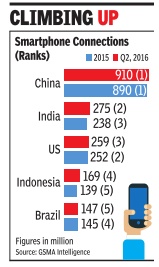Cell/ Mobile phones: India
This is a collection of articles archived for the excellence of their content. Readers will be able to edit existing articles and post new articles directly |
Cell phones: India
Contents |
App(lication)s
App usage by Indians: 2016,17
Ranjani Ayyar, Indians spend 2.5 hrs|day on apps , May 13, 2017: The Times of India
Indians spent 2.5 hours a day on apps in the first three months of 2017, higher than the 2 hours they spent during the same period in 2016. India also ranked ahead of the US, UK, Germany and France where users spent 1.5 -2 hours per day on apps.
Areport by data analytics company App Annie reveals that time spent in apps globally increased to nearly one trillion hours in 2016 with an average usage of 9 apps per day . Brazil, China and India led with over 10 apps used every day . During the first three months of 2017, the average Indian smartphone user had almost 80 apps in stalled on hisher phone and used over 40 apps in a month.
“Consumers have spoken. By and large, they prefer to manage their lives through apps. For many industries, apps are increasingly becoming a must-have,“ the report said.
An interesting observation is that over 80% of time spent in apps was spent outside of the top app. “While this represents a considerable amount of user time, it is far less than some might as sume. There is plenty of user time to go around that is not dominated by major apps such as FB, WhatsApp,“ the report said. 2016 saw the advent of chatbots with players in several sectors including education, fin tech, insurance and health dabbling with bots. While industry insiders touted bots to be the next stage of transformation, it is yet to gain traction in India.“They are still limited to niche use in urban India and are still meant only for the tech savvy consumer conversant in English,“ said Anand Rajkumar, head of marketing, Hasura, a startup that offers an app development platform.
“On the other hand, apps are becoming more mainstream. As telecom and 4G penetration increases, and smartphones become cheaper, a new section of the population is getting connected to the internet. And as several essential functions such as operating a bank account (or even paytm) are much better done through an app, their introduction to the internet necessarily involve apps,“ he said. Experts say apps will continue to grab the larger share of user's time while bots will be useful only for specific processes.
Smart-/ cell- phones: production in India
Ringing Bells
The Times of India, Feb 19 2016
Pankul Sharma
Until Ringing Bells, Goel had small grocery shop
The whole country is today talking about Ringing Bells, Mohit Goel's Rs 251 smart phone His father Rajesh Goel, though, sitting in his smalgrocery shop that proclaims its name to be `Ram ji' on a grey board doesn't know what the fuss is all about. He says he always knew his son would do some thing big. Even in Garhipukhta asmall town in Shamli district o Uttar Pradesh, not many knew about the Goels or their shop. It's a different story today. They are suddenly all that everyone here is discussing. Goel Sr, who is now also one o the directors of the company the directors of the company said, “ After completing his schooling, Mohit went to Noida and competed his graduation from Amity University . The last time that he was home to meet us he had expressed his desire to open a company and I loaned him some money to start what he wanted to. Then he started a mo bile phone company and told us about his venture. Little did we know what it meant then. It's re ally big, is it? We also attended the event where Freedom 251mo bile was launched in New Delhi.“
Mohit, who is the managing director of Ringing Bells, has lived with his father at Garhipuk hta most of his life, often helping around in the grocery shop. On Thursday , Ringing Bells launched Freedom 251, the mobile phone, in a glitzy event in New Delhi that was attended by several dignitaries, including senior BJP's Murli Manohar Joshi.A few residents from Shamli were also invited to the launch.
After completing his schooling from Saint RC Convent School, Mohit earned his engineering degree from Amity University. He recently married Dhaarna, a Noida resident, who is now CEO of Ringing Bells.
6 lakh hits per second lead to co's website crash
This surely is a dampener after the excitement created around the Rs 251smartphone, unveiled by a Noida-based company -Ringing Bells. The company's website only way to book the phone could not f take orders on Thursday. According to those who logged on to the , website, bookings could not be made, even though some had logged in very early in the day. Earlier, Ringing Bells had said that people can make a booking for the phone from its website from 6 am onwards. However, the company in a written message on the website said that an overwhelming response to the offer had over-loaded the servers that , now needed to be upgraded. “... we are very grateful for your enormous response and your kind patronage and would submit that as of now we (have) received approximately six lakh hits per second. As a result of your kind overwhelming response, servers are over loaded. We humbly submit that we are therefore taking a pause and upgrading the service and will revert within or before 24 hours,“ the company said.
NOIDA is the hub: 2016
Pankaj Doval, Aug 26 2016, The Times of India
If you unclip the back of your new Samsung smartphone, or one from a homegrown brand like Karbonn, Lava or Intex, you might find a `Made in India' sticker there. And chances are that the device has been assembled in the Noida-Greater Noida region at Delhi's doorstep.
Ever since the Centre introduced a 10.5% duty differential between imported devices and those made locally in last year's Budget, the region has become India's biggest smartphone hub, with a capacity to make more than 140 million devices per annum -40% more than a year's demand.
Not that Qualcomm and MediaTek are stamping out processors here -all the critical components still come from China and Taiwan -but it is a significant start for the industry . Sources said the local industry does about 5-8% of value addition at present, and this can be scaled up to around 35% within five years.
The flurry of investments to the region was perhaps prompted by the presence of Korean giants Samsung and LG. Samsung, which started local manufacturing a decade ago and reportedly has the highest installed capacity of 40 million devices per annum -the company did not confirm it -seeded a significant number of smartphone com ponent suppliers in the area.The company produces mobile phones from completelyknocked-down (CKD) kits.
“All our mobile phones, from feature phones to the Galaxy S7 that we sell in India, are manufactured at our Noida factory , and we will continue to explore future investment opportunities,“ a spokesperson for Samsung said.
Now Indian brands like Lava, Intex and Karbonn, besides Taiwanese contract manufacturer Wistron, have also set up shop. In partnership with home-grown telecom retailer and manufacturer Optiemus, Wistron makes phones for LG, China's OnePlus and Oppo, and Taiwan's HTC. Another Chinese vendor, Water World Technology , has partnered local company UTL Group, which is one of the backers of Karbonn Mobiles. Each factory creates 3,000-4,000 direct jobs, employing mostly high-school or ITI graduates.
Proximity to Delhi, where most home-grown phone brands are headquartered, has certainly helped the region bloom despite UP's iffy image as a business destination. “The promoters wanted operations in a region that remains within their reach and under their control,“ said Narendra Bansal, chairman of Intex Technologies, a major Indian phone brand.
“Noida's proximity to the capital, its growing infrastructure, and development as a large residential hub close to the capital's business districts also helped,“ the Samsung spokesperson said.
Intex, which has three factories in Noida with an annual installed capacity of 30 million phones (feature and smart), is now setting up a 20-acre base at Kasna in Greater Noida for a larger integrated facility that will also house key suppliers. “There are huge advantages here in terms of the cost and availability of labour. The power supply is largely uninterrupted and the productivity levels are even better than China's in many cases,“ said Sunil Vachani of Dixon Technologies whose company makes Karbonn and Panasonic devices in a joint venture. But is it easy to do business in UP? “The benefits may be less than in states like Andhra Pradesh, which offer incentives. However, operating in the south is difficult for a north-Indian brand. Moreover, the UP administration is supportive,“ Vachani added.
Lava managing director Hari Om Rai said availability of land in the Noida-Greater Noida industrial area has also been an important enabler. “There may be a few instances of difficulty in getting approvals, but the broader policies are clear,“ said Rai whose company has an annual installed capacity of nearly 36 million devices. “We have not faced interventions by the government.“
Now, even Chinese vendors and suppliers are gravitating to the region, drawn by its large production capacities. The manufacturing processes are still low-end, with a lot of assembly done manually , but efforts to increase local engagement and add sophisticated processes, such as the assembly of printed circuit boards (PCB), are on.
Analysts said PCB assembly will enhance the quality of local manufacturing. Also, there are efforts to develop R&D and design capabilities within the country , instead of relying on partners in China and Taiwan. “It will take at least 5-7 years to develop a high valueadd manufacturing set-up here,“ said Pardeep Jain, MD of Karbonn Mobiles.
IT minister Ravi Shankar Prasad said more initiatives are planned to boost the manufacturing of electronics.“Electronics manufacturing is a focus of the government as part of the `Make in India' initiative. The current investments have resulted in as many as 40,000 direct jobs and over 1.2 lakh indirect employment. We estimate that mobile phone production will reach a level of around 500 million devices by 201920.“
For now, uncertainty over the fate of the 10.5% duty differential in a GST regime is worrying investors, even though they have welcomed the simpler tax structure a GST will bring. “It will be near-suicidal to make fresh investments until GST is described,“ Jain said. “We do not want to gamble in such an uncertain scenario,“ Vachani added.
Minister Prasad said concerns around GST would be addressed.“Please remember, GST is for India.Surely , in the whole fiscal architecture we will ensure that Indian manufacturing interests are saved.“
Asked if the duty differential between local manufacturing and imports will be maintained, he said, “Obviously , why not... the interest of India's manufacturers will be kept in mind.“
2017/ production worth more than 1 lakh crore
Pankaj Doval, India-made phones hit Rs 1L cr in FY17, Feb 11 2017: The Times of India
Mobile phones worth nearly Rs 1 lakh crore are expected to be produced locally by the end of this financial year (2016-17), more than five times compared to two years back, as companies churn out around 200 million devices in one of the world's fastest-growing market.
The growth in output is a heartening development for the government, which has been pushing manufacture of electronics in the country , led by a lower duty regime for devices produced in-house.
“India will be producing mobile phones worth Rs 97,000 crore this fiscal, a quantum jump when compared to the Rs 18,900 crore achieved in 2014 15,“ IT minister Ravi Shankar Prasad told TOI here.
Prasad said that nearly 40 new factories have come up in the country during this period, and these have been joi ned by nearly three-dozen top ancillary makers. “If you look at the output, India is expected to locally-produce nearly 200 million devices this fiscal against 60 million units two years back.“
Local production enjoys around 12% incentive compared to imported products, and this has been a major incentive for companies to look inwards. A large number of companies have started manufacturingsourcing locally over the past two years and these include some of the top Chinese names such as Huawei, LenovoMotorola, Xiaomi and Gionee. Homegrown brands such as Intex, Lava, Karbonn and Micromax have also been boosting local output.
Smart-phone usage in India
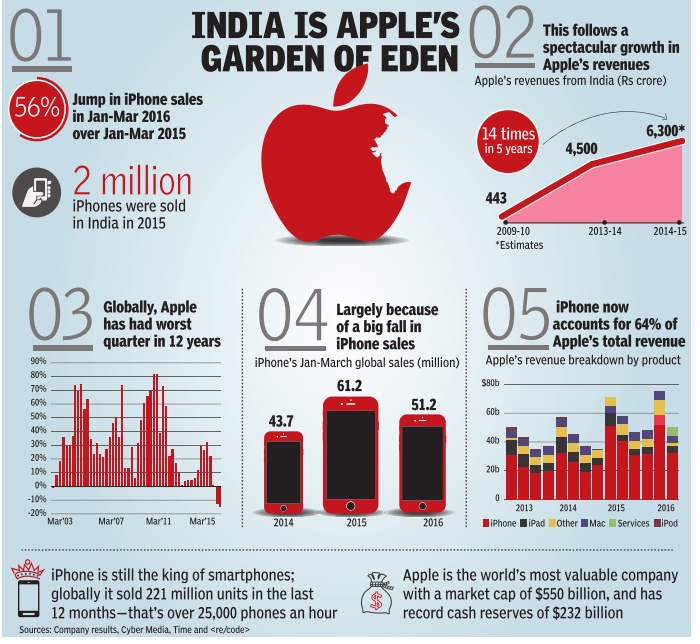
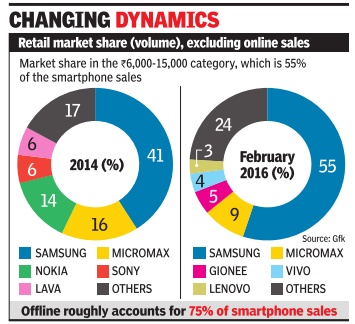
2015-16: India is world’s no2 market
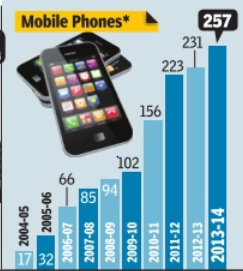
Pankaj Doval, India pips US in smartphone connections, Oct 27 2016 : The Times of India
Becomes No. 2 After China
India has become the second-biggest market globally in terms of smartphone connections, overtaking the US and trailing only China. More and more Indians are logging on the internet using their mobiles, aided by availability of low-priced smartphones -a significant number of them assembled locally and sold for as low as Rs 3,000 -and rapid expansion of 3G and 4G networks.
According to figures provided by global telecom body GSMA, smartphone connections in India at the end of the first half of this year (ending June 2016) stood at 275 million, higher than 259 million connections in the US. China, however, leads by a huge margin with overall smartphone connections at 910 million.
Alasdair Grant, the head of Asia for GSMA, told TOI that the growth in smartphone connections will continue to remain strong in coming years as 3G and 4G networks spread rapidly across the country .The growth will be fuelled further with the entry of new operators such as Reliance Jio.
Grant added that 4G connection base is forecast to grow from 3 million at the end of 2015 to 280 million by 2020. “Mobile broadband (3G and 4G) will account for nearly 50% of total connections in India by then.“
GSMA said mobile operators are investing heavily to improve network coverage, and this should see 3G being available to 90% of the population by 2020, while 4G to 70%, the latter registering a 14-fold increase from now.
Most of the mobile manufacturers have also read the trend as the majority of new device launches by them are only 3G and 4G compatible as 2G devices -which are mainly feature phones -are being discontinued. Total mobile users in India (some may carry multiple SIM cards) stood at 616 million at the end of June, GSMA said. “ Almost half of the country's population now subscribes to a mobile service, indicating the significant growth potential in the coming years, particularly from the rural and under-penetrated segments.“
In its `India Mobile Economy' report, GSMA estimates that 330 million new mobile users will be added by 2020. This would push up the mobile phone penetration base across the population to 68% against 47% at the end of 2015.
2016, a slide in sale
The Times of India, Jan 16, 2017
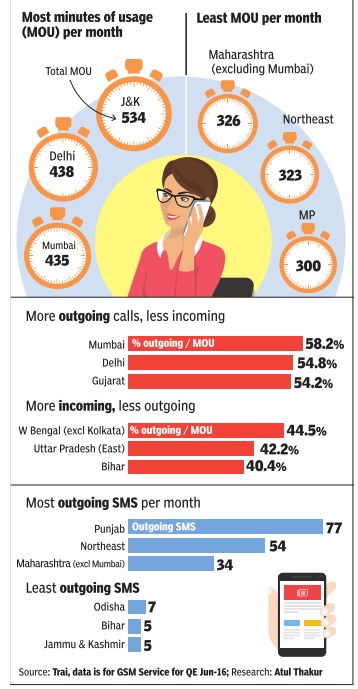
Pankaj Doval, Dragon edges out Indian smartphone cos from top 5, Jan 25 2017, The Times of India
It has been a rapid slide for Indian smartphone manufacturers as Chinese companies strengthen their grip on buyers. Led by Micromax, homegrown brands have taken a beating as Chinese phone makers such as Vivo and Lenovo strengthen their hold, driven by new devices and aggressive marketing strategies.
None of the Indian brands figure in the top-five smartphone ranking released for Q4 of 2016, a far cry from the Q1 where three brands in top five were Indian, according to Counterpoint. The pressure from the Chinese brands is so intense that even Samsung, which still leads the market, has seen its share down at 24% in Q4 of 2016 against 29% in first quarter.
While Chinese brands have been investing aggressively over the last few years, their large-scale acceptance among buyers surprises many . The general perception was Chinese brands were poor in quality and lacked bandwidth to service their phones. But this has be en changing as Chienese companies make inroads into offline retail stores, while becoming highly-visible via heavy investments in big-ticket sporting and entertainment events.
Vivo came up strongly to finish the fourth quarter with a share of 10%, second behind Samsung. It was followed by Xi aomi, Lenovo and Oppo. “Indian companies are not refreshing product line-up. Their access to new technologies and components is limited,“ said Tarun Pathak, the telecom sector analyst at Counterpoint. “Chinese companies are winning offline retailers by giving them better margins.“
SIM cards
SC: Link SIMs to users' Aadhaar IDs
Dhananjay Mahapatra, Link SIMs to users' Aadhaar IDs: Court, Feb 7, 2017: The Times of India
The Supreme Court directed the Union government on Monday to register identity details of all 105 crore mobile phone users by linking their SIM cards to their Aadhaar number.
While giving this direction to the Centre, a bench of Chief Justice J S Khehar and Justice N V Ramana commended advocate Ashok Dhamija for filing the PIL on behalf of NGO `Lokniti Foundation' seeking 100% verification of cell phone subscribers with regard to their identity and address by linking their phone numbers to their Aadhaar cards.
Attorney general Mukul Rohatgi said the Union government was agreeable to the idea. “But the task is gigantic as more than 90% of the 105 crore subscribers are using prepaid SIM cards. These SIM cards get recharged at roadside kiosks, making it difficult to register them,“ he added.
The bench said, “The gov ernment has to devise a method. The person who comes for recharge of the phone should be given a form to give his details including Aadhaar number. He should submit the filled form the next time he goes for recharge. You can give him more time. May be three or four recharges before he furnishes the details. But make it mandatory that he must furnish details or else there would be no recharge of prepaid SIMs.“
The AG said, “Taking coercive measures immediately could be difficult. After demonetisation,cell phones are used for several activities. How long it would take to register each and every cell phone user is difficult to estimate.“ The bench would have none of it and told the AG that the government may take one year to complete the task but it has to do it.When the AG said the government would put in place an effective mechanism to register details of all subscribers, the bench disposed of the petition saying it would be done not later than one year.
Tax on chargers
Levy tax on chargers sold with cellphones: SC
Dec 20 2014, The Times of India
AmitAnand Choudhary
The Supreme Court has held that chargers sold with cellphones should be taxed separately as they are not part of a phone but are an accessory and turned down a plea by Nokia for treating them as a composite product.
The SC said merely making one package of a phone and a charger will not make it a composite product and quashed the Punjab and Haryana high court order which held a charger cannot be excluded from the concessional rate of tax which applies to cellphones. The case pertains to Punjab where under state Value Added Tax Act, sale of mobile phone is taxed at 4% while charger is taxed at 12.5%.
“If the charger was a part of cellphone, then cellphone could not have been operated without using the battery charger.But in reality , it is not required at the time of operation. Further, the battery in the cellphone can be charged directly from the other means also like laptop without employing the battery charger, implying thereby , that it is nothing but an accessory to the mobile phone,“ a bench of justices SJ Mukhopadhaya and Madan B Lokur said.
See also
Telecommunications 2: Indian government data
Cell/ Mobile phones: India
